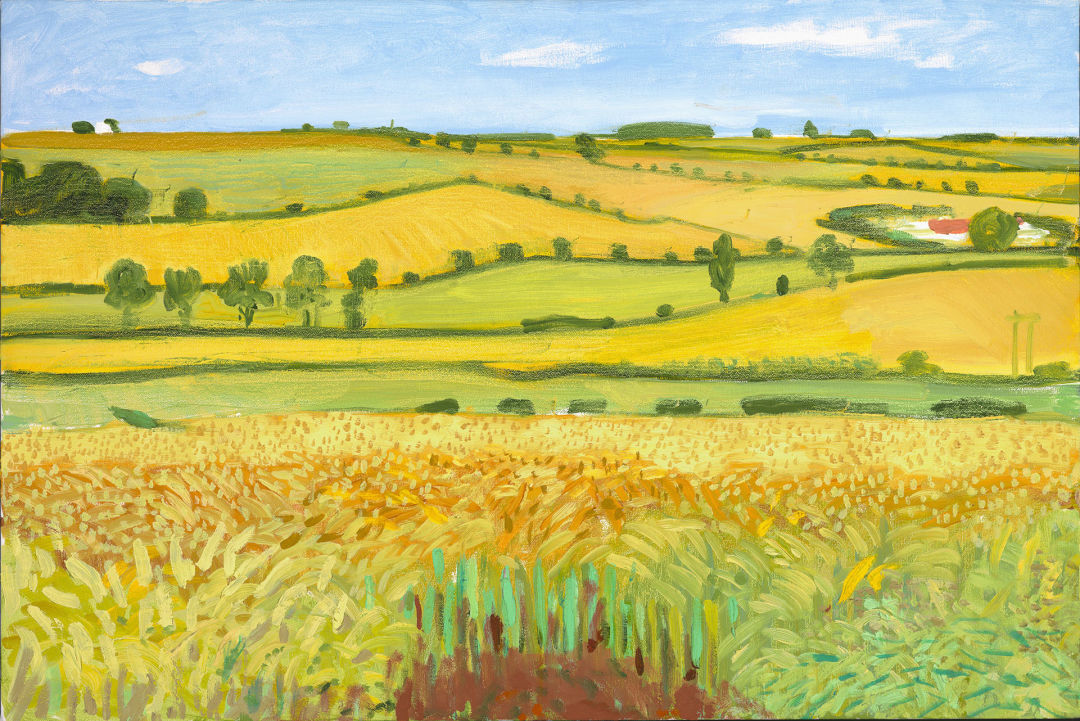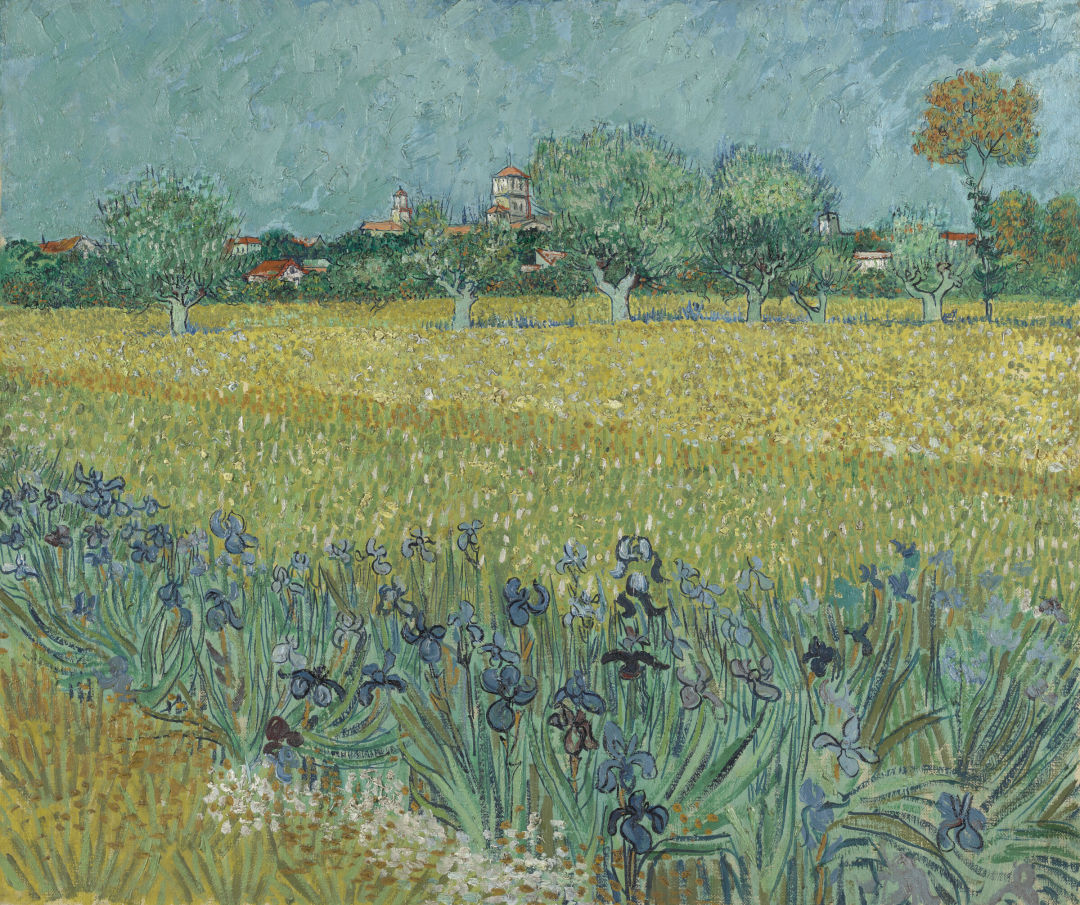MFAH’s The Joy of Nature Ushers Visitors into Spring

David Hockney's Woldgate Vista, painted July 27, 2005, oil on canvas.
Image: Richard Schmidt
Do you need an escape from these dreary days? Or to forget about Houston’s uncharacteristically chilly winter? On display through June 20 at the Museum of Fine Arts, Houston, Hockney – Van Gogh: The Joy of Nature ushers visitors into springtime via the vivid landscapes of Vincent van Gogh and British artist David Hockney.
Originally debuted at Amsterdam’s Van Gogh Museum in 2019, the MFAH exhibition features two visual masters who are separated in time by a century but united in their study of color, seasonality, and the beauty of the natural world.
Cleverly arranged against brightly painted backdrops in MFAH’s Beck Building, Hockney’s sprawling, multi-paneled landscapes mesmerize and exhilarate. But the exhibition is more than an aesthetic triumph; by combining van Gogh’s nature pieces with Hockney’s sketches, iPad drawings, videography, and oil paintings, visitors can trace the influence of the Dutch master’s scenes in the South of France to his British successor’s illustrations of landscapes in northern England.
“Hockney loves van Gogh,” says exhibition curator Ann Dumas. “There’s a connection, really.”
Dumas, MFAH’s consulting curator of European Art, argues that despite the comparatively darker tones of van Gogh’s landscapes, his eccentric use of color was considered avant-garde in the late 19th century, when historical paintings and realism reigned. Over a century later, Hockney stretches the limits of the standard color palette even further, making use of vibrant, synthetic pigments that were unavailable while van Gogh was active. In Hockney’s May Blossom on the Roman Road (2009), one observes van Gogh’s trademark brushstrokes twirling across the summer sky, but the outsized influence of early 20th-century fauvism is visible as well; Hockney’s road is painted a cheery red-orange, and a smattering of lavender and clementine colors dot the adjacent flowers in bloom.
Once a mainstay in visual art, landscapes are a rare subject for contemporary painters; indeed, Hockney rose to prominence as a portraitist and gained special notoriety for his swimming pool paintings he produced while residing in California. The illnesses of his mother and a close friend in the late ‘90s brought him back to his home county of Yorkshire, where he began to focus primarily on the natural world. Midsummer: East Yorkshire (2004) represents the earliest of Hockney’s work from this period. Composed of 36 watercolor pieces painted en plein air, the series acts as an introduction to Hockney’s study of his native north English countryside.

Vincent van Gogh's Field with Irises near Arles, 1888, oil on canvas.
Visitors will relish in a surprising variety of media, though no matter the format—painting, charcoal sketch, or digital illustration—Hockney’s technical talent is immense. Per Dumas, the octogenarian artist has always experimented with novel forms of technology, exhibiting a multi-media versatility rare for a painter of his caliber. He first began printmaking as a student in the 1950s, but after stumbling upon a friend’s Xerox copy machine in 1986, Hockney became enamored of the “great speed and responsiveness” of the copier. “This is the closest I’ve ever come in printing to what it’s like to paint,” he told Christie’s Auction House in 2018. “I can put something down, evaluate it, alter it, revise it, all in a matter of seconds.”
Hockney’s affinity for technology and innovation is on display in his series of iPad drawings, The Arrival of Spring in Woldgate, East Yorkshire in 2011, as well as his video collection, The Four Seasons, Woldgate Woods (2010–11). Using a stylus and the application’s brushes, Hockney documents seasonal transition as never seen before–one wonders if van Gogh would have experimented with similar technology were he alive today.
The Four Seasons, Woldgate Woods, is perhaps the most enchanting area of the exhibition; four nine-paneled screens, each depicting the same road in the height of each season, surround the viewer, offering them a simultaneous portrait of winter, spring, summer, and fall. The steady panning of the cameras across the forest’s understory acts like a visual lullaby.
MFAH’s inclusion of both van Gogh and Hockney’s sketches is a credit to the museum’s curatorial staff. The joint presentation of van Gogh’s View of Arles, a paper sketch, and its final product, Field with Irises near Arles, offers an extraordinary glimpse into the artist’s creative process, and, according to Dumas, is the first time the pair of illustrations have appeared together since 1986. For Hockney’s part, the exhibition presents his accordion sketchbook filled with the studies of flora that would later line the roads in his oil paintings.
Such meticulous attention to detail is ubiquitous in the exhibition. Above all else, The Joy of Nature is reminder to remain attuned to our surroundings, to extract the beauty from the mundane, as both artists managed to do in the 50-plus works on display. Facing criticism for his focus on landscapes, Hockney chided detractors for their lack of engagement with nature. “It’s not the landscape that’s boring,” he says in a Van Gogh Museum interview that’s featured at the MFAH exhibition. “It’s the depictions of it that have become boring.”
“You can’t be bored of nature, can you?”
Hockney – Van Gogh: The Joy of Nature is on display through June 20, 2021. The Museum of Fine Arts, Houston recommends purchasing advanced tickets at mfah.org because of pandemic-related restrictions.




